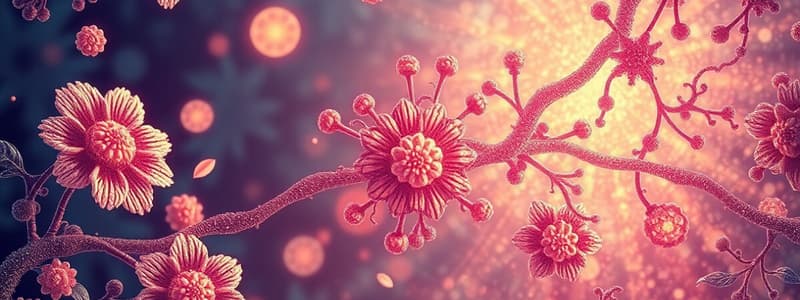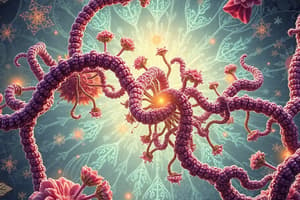Podcast
Questions and Answers
What is the primary mechanism by which most drugs exert their effects?
What is the primary mechanism by which most drugs exert their effects?
- By increasing metabolic rate
- By interacting with macromolecular components (correct)
- By altering DNA structure
- By stimulating immune responses
What occurs when a drug-receptor complex is formed?
What occurs when a drug-receptor complex is formed?
- The drug is eliminated from the body
- Cell division is stimulated
- The drug is neutralized
- A biologic response is initiated (correct)
What type of drug mimics the effects of endogenous signaling compounds?
What type of drug mimics the effects of endogenous signaling compounds?
- Antagonists
- Agonists (correct)
- Receptor inhibitors
- Partial agonists
Which of the following best describes partial agonists?
Which of the following best describes partial agonists?
Which receptor family is associated with rapid responses by altering ion flow through plasma membrane channels?
Which receptor family is associated with rapid responses by altering ion flow through plasma membrane channels?
What happens to the number of drug-receptor complexes as the magnitude of the response increases?
What happens to the number of drug-receptor complexes as the magnitude of the response increases?
Which of the following ligands is associated with ligand-gated ion channels?
Which of the following ligands is associated with ligand-gated ion channels?
What is a characteristic feature of receptors in pharmacodynamics?
What is a characteristic feature of receptors in pharmacodynamics?
What initiates the activation of the G protein on the cytoplasmic face of the plasma membrane?
What initiates the activation of the G protein on the cytoplasmic face of the plasma membrane?
What is the role of second messengers in the signaling process?
What is the role of second messengers in the signaling process?
Which statement accurately describes intracellular receptors?
Which statement accurately describes intracellular receptors?
Which process is NOT associated with the activation of G proteins?
Which process is NOT associated with the activation of G proteins?
How do enzyme-linked receptors function when a ligand binds?
How do enzyme-linked receptors function when a ligand binds?
Which of the following options accurately represents an aspect of the GPCR cycle?
Which of the following options accurately represents an aspect of the GPCR cycle?
What occurs after the activation of a G protein?
What occurs after the activation of a G protein?
Which second messenger is typically associated with the GPCR signaling pathway?
Which second messenger is typically associated with the GPCR signaling pathway?
What is a graded dose-response curve used to represent?
What is a graded dose-response curve used to represent?
What does potency refer to in pharmacology?
What does potency refer to in pharmacology?
How is efficacy defined in relation to pharmacologic agents?
How is efficacy defined in relation to pharmacologic agents?
What does the EC50 value represent in pharmacology?
What does the EC50 value represent in pharmacology?
Which statement correctly differentiates potency from efficacy?
Which statement correctly differentiates potency from efficacy?
What does a sigmoid curve on a semi-logarithmic concentration axis indicate?
What does a sigmoid curve on a semi-logarithmic concentration axis indicate?
What mainly determines the efficacy of a drug?
What mainly determines the efficacy of a drug?
Which of the following is NOT a factor that influences clinical effectiveness of a drug?
Which of the following is NOT a factor that influences clinical effectiveness of a drug?
What is primarily measured to determine the efficacy of a drug?
What is primarily measured to determine the efficacy of a drug?
Which of the following statements regarding partial agonists is correct?
Which of the following statements regarding partial agonists is correct?
What does a smaller Kd value indicate about a drug?
What does a smaller Kd value indicate about a drug?
Which graph would be used to measure the fraction of a population showing a specified response at increasing drug doses?
Which graph would be used to measure the fraction of a population showing a specified response at increasing drug doses?
What role do inert binding sites play when a drug is administered?
What role do inert binding sites play when a drug is administered?
Which two plasma proteins are known for their significant drug-binding capacity?
Which two plasma proteins are known for their significant drug-binding capacity?
What is an intrinsic property of a partial agonist?
What is an intrinsic property of a partial agonist?
Which aspect is NOT used to measure drug efficacy?
Which aspect is NOT used to measure drug efficacy?
What happens to Emax of an agonist in the presence of a partial agonist?
What happens to Emax of an agonist in the presence of a partial agonist?
Which type of antagonist permanently inhibits receptor activation?
Which type of antagonist permanently inhibits receptor activation?
What distinguishes a physiologic antagonist from a pharmacologic antagonist?
What distinguishes a physiologic antagonist from a pharmacologic antagonist?
What effect do competitive antagonists have on ED50 values?
What effect do competitive antagonists have on ED50 values?
What defines the therapeutic index of a drug?
What defines the therapeutic index of a drug?
What does the therapeutic window represent?
What does the therapeutic window represent?
In the context of agonists and partial agonists, what role does a partial agonist play when a full agonist is present?
In the context of agonists and partial agonists, what role does a partial agonist play when a full agonist is present?
What characterizes the action of chemical antagonists?
What characterizes the action of chemical antagonists?
Flashcards are hidden until you start studying
Study Notes
Pharmacodynamics
- The effects of drugs on biologic systems are studied in pharmacodynamics.
- Drugs often interact with macromolecules within the organism, leading to biochemical and physiological changes.
- Drug-receptor interactions are central to drug actions, and the response is proportional to the number of drug-receptor complexes formed.
Receptors and Ligands
- Receptors are specific molecules that drugs interact with to alter biological system function.
- Receptors must be selective for specific drugs and modifiable by drug binding.
- Agonists are drugs that bind to receptors and mimic endogenous regulatory effects.
- Antagonists block the effects of agonists without producing any regulatory effect of their own.
- Partial agonists are less effective than full agonists at any dose.
Receptor Families
- Ligand-gated ion channels regulate ion flow across plasma membranes.
- Examples of natural ligands include acetylcholine, serotonin, GABA and glutamate.
- These receptors alter membrane potential by altering ion conductance.
- The response is very rapid.
- G Protein-Coupled Receptors (GPCRs): Initiate intracellular signaling through second messenger pathways.
- Extracellular ligands bind to a cell-surface receptor.
- The receptor activates a G protein on the inner face of the membrane.
- The activated G protein alters the activity of an effector element, usually an enzyme or ion channel.
- Examples of second messengers include adenylyl cyclase and phospholipase C.
- Enzyme-Linked Receptors: Ligand binding to an extracellular domain activates or inhibits intracellular enzyme activity.
- Intracellular Receptors: Receptors are entirely located within the cell.
Graded Dose-Response Relationship
- As drug concentration increases, the magnitude of its pharmacological effect also increases.
- The relationship between dose and response is continuous.
- The graded dose-response curve plots the response against increasing drug concentration or dose.
- The curve is typically sigmoidal when plotted on a semi-logarithmic concentration axis.
- Efficacy (Emax) represents the maximum effect an agonist can produce.
- Potency (EC50 or ED50) is the concentration or dose required to produce 50% of the drug's maximal effect.
- Potency is influenced by the affinity of receptors for the drug (Kd).
Graded Dose-Binding Relationship and Binding Affinity
- The relationship between drug concentration and the fraction of receptors bound can be plotted similarly to a dose-response curve.
- Kd is the concentration required to bind 50% of the receptor sites.
- Kd measures the affinity of a drug molecule for its binding site on the receptor.
- Lower Kd indicates higher affinity.
Quantal Dose-Response Relationships
- These curves plot the fraction of a population exhibiting a specific response at progressively increasing doses.
Inert Binding Sites
- These are components of endogenous molecules that bind drugs without triggering any effects.
- Inert binding sites buffer drug concentrations by reducing the free drug available.
- Most important plasma proteins for drug binding are albumin and orosomucoid.
Agonists and Partial Agonists
- Full agonists fully activate the effector system when bound to the receptor.
- Partial agonists produce less than the full effect even when saturating the receptors.
- They have lower intrinsic activity than full agonists.
Antagonists
- Competitive Antagonists: Bind reversibly to the receptor site, preventing agonist binding without activating the effector system.
- Shift the dose-response curve to higher doses but don't alter the maximum effect.
- Irreversible Antagonists: Bind irreversibly to the receptor, causing a downward shift in the maximum effect and a potential shift in the dose axis if spare receptors are present.
- Effects cannot be overcome by increasing agonist concentration.
- Functional/Physiological Antagonists: Act on different receptors, producing effects opposite to the agonist.
- Chemical Antagonists: Directly interact with a drug, removing it or preventing it from reaching its target.
Therapeutic Index and Therapeutic Window
- Therapeutic Index (TI) is the ratio of the dose causing toxicity (LD50) to the dose producing a desired effect (ED50).
- TI reflects drug safety.
- Therapeutic Window is the dosage range between the minimum effective dose and the minimum toxic dose.
Studying That Suits You
Use AI to generate personalized quizzes and flashcards to suit your learning preferences.




